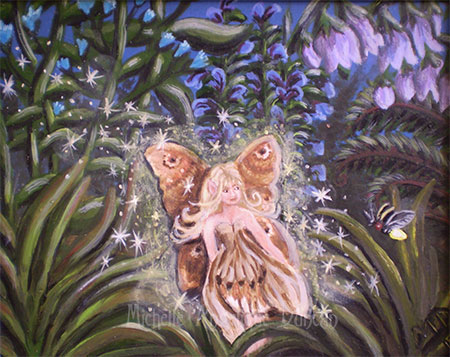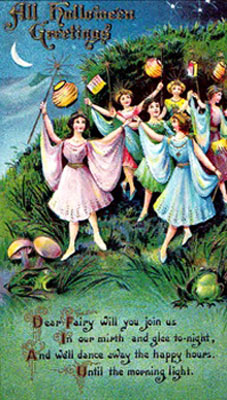
Faerie Welcoming Party
-By Angelique Duncan
Many believe that beginning May marks the return of the faeries from their winter slumber in the underworld. The veil between our world and theirs is lifted and they hold a grand procession and feast to celebrate the end of winter and kick off their stay in the human world until they pass back to the through the veil on Halloween night.
As a way to celebrate the return of the faeries one can hold their own faerie party. Here are a few ideas for hosting a grand celebration fit for the fae folk. Faerie parties aren’t just for children; adult children can indulge in faerie celebrations as well.
Begin with invitations. Send a small vile of glitter or bubbles to your guest with the invitation attached with ribbon or twine. Or send a frilly decorative floral paper invitation, some thing that would intrigue a faeries interest.
Instruct your guest to wear their best faerie attire. This is a great opportunity to have a costume party in the middle of spring. Encourage floral headdresses, accessories and fluffy skirts, garden hats and of course the wearing wings!
If your guests don’t already own a pair of wings then this could become a party activity. Have materials on hand to make simple wings from netting and wire and glue guns to affix flowers and adornments. The same could be done with making wands. Another activity could be to have your guest decorate faerie houses or flower pots that they can take with them to attract faeries to their own gardens.
On the invitation also ask your guest to bring a small shiny token as a gift to the faeries. This can be anything they want to offer the fae; a bead, chain, coin or anything sparkly or floral in nature. Folklore tells us that faeries are intercity attracted to shiny objects and they are pleased when gifts are left for them. It is said that gifts left for the faeries will ensure they will not destroy ones garden. As an activity for the party the shiny objects can be left either at an alter created in ones garden or if in an apartment left under plants and pots for the faeries to find.
Since this will be a celebration of the faeries return it must include a faerie feast. Think dainty and be creative. Serve finger sandwiches, tiny quiche, and pinwheels. Make “faerie toast “ by spreading butter on bread and sprinkling with cinnamon and sugar or colored sugars and putting in the oven or toaster until brown on the bottom and the butter is melted. Cut into squares or quarter triangles. Serve sweets! Faeries love sugary things, cookies, mini cupcakes, be creative and think like a faerie.
Along with the offering of gifts that are left for the faeries make a food alter.Have your guest leave tiny bits of the faerie food or sugar cubes at the alter for the winged creatures to find. Fill thimbles with milk and honey and leave them with the food offerings.
It is said that faeries are most active at twilight so schedule the party in the late afternoon before it get gets dark so that at dusk you and your guest can welcome and watch for the faeries.
These are just some ideas to get you started. The possibilities for a faerie welcoming party are endless. Be creative and remember you are never too old to believe in faeries.
![]()
Painting “Garden at Twilight” copyright Angelique Duncan -Twilight Faerie
Digital illustration “Little Sprite” copyright Amethyst Raven and available for sale on Little Sprite.Etsy
Angelique Duncan is proprietor of Twilight Faerie Nostalgic and Capricious Objects. Check out her artist page to find links to her shops and vintage inspired traditional holiday art. Visit again next month for more traditions and folklore.

